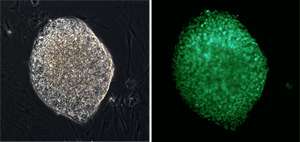Technique to make human embryonic stem cells more closely resemble true epiblast cells

Human embryonic stem cells (hESCs) have the ability to both convert into any cell type in the human body and to proliferate indefinitely in the laboratory. However, cultured hESCs, which are plucked from the developing embryo and then grown in vitro, often display a number of biological differences when compared to the pluripotent epiblast cells in the early embryo from which they originated.
Now, a team of researchers at the A*STAR Genome Institute of Singapore (GIS) has developed a way to make hESCs more closely resemble true epiblast cells.
"We found that pluripotent human embryonic stem cells can be transformed into a state that is closer to how they appear in real life," says Huck Hui Ng, executive director of the GIS, who led the research. "This new cell state has the potential to improve many applications of hESCs, such as disease modeling."
To induce the more native state, Ng and his colleagues screened 11 small molecules to find those that promoted the expression of NANOG, a gene involved with self-renewal. The researchers identified a cocktail of three chemicals, plus the growth factor LIF (3iL), that nearly doubled NANOG expression levels in the hESCs while maintaining these cells in a state of perpetual growth. They called the resulting stem cells '3iL' hESCs.
The chemically treated and non-treated hESCs expressed similar levels of a handful of genes that underlie pluripotency, the ability to both self-renew and to develop into any cell type. But only the 3iL stem cells had a gene expression profile that closely matched that of epiblast cells taken straight from early embryos. Study author Jonathan Göke suggests that laboratory culturing could have rewired certain regulatory networks in conventionally grown hESCs. "The 3iL treatment potentially resets this process," he says.
"Culture conditions have been optimized to support self-renewal, and these culture conditions are very different from the complex signaling and communication system of embryos," notes Yun Shen Chan, another author on the study. "Therefore, it seems like the culture conditions used to grow hESCs might partly explain the differences between lab-cultured hESCs and in vivo epiblast cells."
The researchers also explored whether the 3iL recipe could be applied to induced pluripotent stem cells (iPSCs), which are adult cells reprogrammed into an embryonic-like state. "A full comparison of 3iL iPSCs with 'standard' iPSCs still has to be done," Chan says, "but our preliminary results indicate that 3iL could result in iPSCs of higher quality."
More information: Chan, Y.-S., Göke, J., Ng, J.-H., Lu, X., Gonzales, K. A. U. et al. "Induction of a human pluripotent state with distinct regulatory circuitry that resembles preimplantation epiblast." Cell Stem Cell 13, 663–675 (2013). dx.doi.org/10.1016/j.stem.2013.11.015
Journal information: Cell Stem Cell















